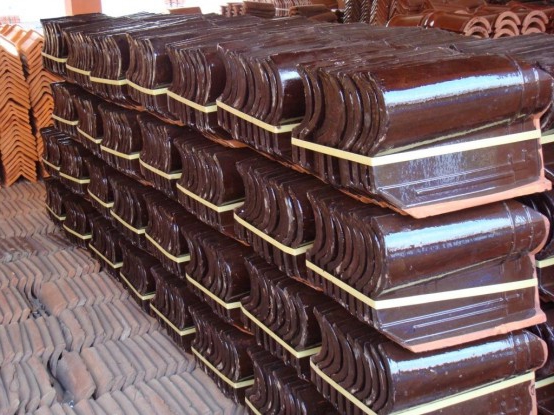Ceramic tile is the oldest type of roofing with a long history. Despite the huge variety of modern finishing materials, she confidently leads in its segment. The production technology for this period has not changed much, only the equipment for the production of ceramic tiles has been improved. Consider this popular type of roof, its manufacturing method and advantages.

Production technology
The complexity of the technological process implies that industrial equipment is used for the production of ceramic tiles, eliminating the possibility of artisanal manufacturing.
The prepared clay is mixed with water until a homogeneous plastic mass is obtained, compacted and squeezed out in the form of a flat tape, which dissolves into fragments of a certain size. In the drying process, temperature and humidity control is mandatory in order to avoid uneven shrinkage, cracking and curvature of the finished product. Firing completes the manufacturing process, giving the tile strength and water resistance.
Heat treatment is an energy-intensive cycle, this is what determines the high price of clay products. The ceramic tile production line is for the most part an automated process that increases productivity and improves product quality.

The natural color of the tiles is terracotta, therefore, in order to change it, the surface having the shape of a tile is covered with special compositions during firing:
- engobe - white-burning or colored clay, providing a stable color;
- glaze - a glassy coating applied to the product and fixed firing.
Using the latest equipment for the production of ceramic tiles, they completely exclude cases of malfunctions due to the "human factor". Control at all stages of the redistribution lies on the automation, largely due to this, a very high quality product is achieved.
Protective coating fastening
Installation work includes laying on the rafters of the insulation, waterproofing and vapor barrier layers, counter battens, and on top of the battens. The step of the wooden flooring is affected by the heavy weight and size of the ceramic tile. It is calculated individually and depends on the model. Row marking is done with a cord.
The roof covering is laid from right to left, then - from bottom to top. The large weight of ceramic tiles determines its placement on the roof before installation - in stacks of 5 pieces for uniform distribution of the load on the crate and rafters.
Fasteners are made with galvanized screws. With a slope of more than fifty degrees, the roofing material is additionally fixed with clamps. The grooved tiles must be laid with a single overlap, and a flat, respectively, with a double. The tile located in the upper row should overlap the joints of the two lower ones.

The installation of ceramic tiles is a job requiring high qualification, therefore it should be trusted only by professional roofers.
Advantages of ceramic tiles
Only strictly observing the technology and using specialized equipment for the production of ceramic tiles, you can be sure that the durability of this roofing material will be about one hundred years. The advantages of a unique coating include:
- environmentally friendly raw materials;
- reliable sound and heat insulation;
- ease of repair;
- low water absorption;
- resistance to weathering, temperature extremes;
- minimum waste during installation.
Cons of clay roofing
The disadvantages of natural tiles are a small amount:
- high cost, which is covered only by an extended service life;
- the impossibility of mechanization of installation works, an increase in the cost of arranging the rafter system by 20%, while the reliability of the coating is very highly evaluated;
- the choice of colors is limited only by natural shades.

The exterior of the house, covered with ceramic tiles, becomes aesthetically attractive, exuding coziness and comfort. This roofing gracefully repeats all the bends of the roof, looks spectacular, standing out by the restrained nobility of natural materials. This quality is truly time-tested.
